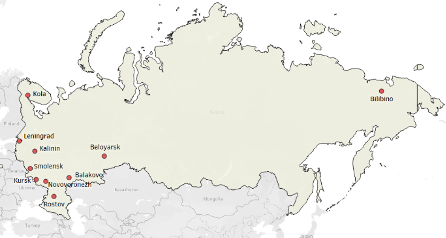Highlights
22,449 metric tons spent nuclear fuel in storage (2016)
69,875 metric tons spent nuclear fuel projected by 2050
1964 First year of commercial nuclear operation
38 operating nuclear power reactors
29 operating research and test reactors
4 power reactors under construction (15 planned by 2037)
29.04 GW(e) installed nuclear capacity (2018)
4.68% nuclear share of domestic energy production (2018)
Regulator: Rostechnadzor (Federal Environmental, Industrial and Nuclear Supervision Service)
Power Operator: Rosatom

Management and Disposal of Spent Nuclear Fuel
Practices
- Commercial fuel reprocessing has been in place since 1977 and development at Mayak Production Association and the Mining and Chemical Combine (MCC) facilities has been underway for further reprocessing
- After removal from power reactors, fuel is stored for at least three years before transport to reprocessing plants, except for RBMK and VVER-1000 fuel, which is not reprocessed
- Spent fuel from nuclear-powered icebreakers is stored in Atomflot’s dry storage
- Research reactor fuel is sent to PA Mayak after temporary wet storage
- In 2009 the government announced a $3.89 billion program on advanced reactors and closing the fuel cycle
- In 2016 a site in Krasnoyarsk Territory was approved for construction of a repository for 4500 m3 class 1 waste and 155,000 m3 class 2 wastes, and another site in the region is a candidate for an underground research laboratory beginning construction in 2017 with repository completion in 2035
Obligations
- Russia is a nuclear-weapon State and has a voluntary offer agreement with the IAEA (INFCIRC/327) since 1985 and an additional protocol since 2017
- Russia signed the Joint Convention in 1999 and ratified in 2006
- Recent Russian policy dictates development of a closed fuel cycle through MOX fabrication and uranium recycling, with the goal of closing the fuel cycle by 2030
- The Federal Target Programme “Nuclear and Radiation Safety in 2016–2020 and until 2030” outlines further infrastructure development for nuclear energy over the next decade
- By 2050 the intention is for all SNF to be reprocessed for fast reactor use, but until MCC operations begin in 2022, fuel will continue to build up in storage
- Responsibility of radioactive waste (RW) producing organizations for safety in RW management until its transfer to the national operator responsible for disposal – Federal State Unitary Enterprise


